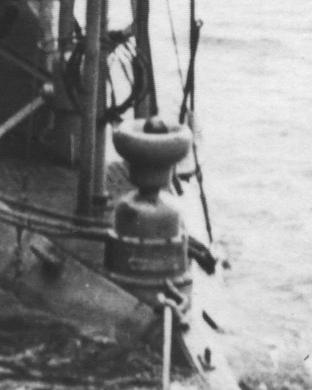Allied Signal Bell: Difference between revisions
Pbcjohnston (talk | contribs) Created Signal Bell page |
Pbcjohnston (talk | contribs) Added new Header |
||
| (2 intermediate revisions by the same user not shown) | |||
| Line 1: | Line 1: | ||
[[File: | [[File:New Header 1 A-class.jpg]] | ||
<div style="text-align: justify;"><span style="color:#00008B"> | [[File:Allied Signal Bell.jpg|left|500px]] | ||
<div style="text-align: justify;"><span style="color:#00008B">This strange object seen on a lot of early submarines has been mistaken for several different items. It has been thought to have been a ventilator, a capstan, and a messenger buoy. It is in reality a signaling bell. | |||
Allied Signal developed this bell for communicating between submarines underwater, and between a submarine and a surface ship. It is an actual bell with an air operated clapper. The bell was operated from inside the boat using an actuation valve to send air pulses to the clapper. By manipulating the valve, Morse code signals could be sent which would be picked up by the receiving boat. In most cases the gongs could be heard through the hull if the receiving boat was close enough, but for distant ranges the receiving boat could use hydrophones. Chester Nimitz, one of our early submarine commanders, envisioned using the bell to coordinate the attack runs of several harbor defense submarines as they closed to attack enemy ships in their harbor. The bell could also be used in an emergency, to assist rescue forces in finding a downed submarine. | |||
As shown here the bell was mounted on the deck for the A through the G-class boats. Starting with the H-class the bell was mounted in a keel location, so that it could be used both surfaced and submerged. In essence it was an early form of sonar, but used only for communication and not location finding. A later outgrowth was the much more sophisticated Fessenden Oscillator, whose circular plate-shaped transducer could be seen on either side of the bow near the keel on late L and most R, O, and early S boats. The Fessenden device incorporated both pinging and listening into one device. | |||
[[File:Red bar sub new.jpg]] | [[File:Red bar sub new.jpg]] | ||
Latest revision as of 18:13, 13 March 2025

Allied Signal developed this bell for communicating between submarines underwater, and between a submarine and a surface ship. It is an actual bell with an air operated clapper. The bell was operated from inside the boat using an actuation valve to send air pulses to the clapper. By manipulating the valve, Morse code signals could be sent which would be picked up by the receiving boat. In most cases the gongs could be heard through the hull if the receiving boat was close enough, but for distant ranges the receiving boat could use hydrophones. Chester Nimitz, one of our early submarine commanders, envisioned using the bell to coordinate the attack runs of several harbor defense submarines as they closed to attack enemy ships in their harbor. The bell could also be used in an emergency, to assist rescue forces in finding a downed submarine.
As shown here the bell was mounted on the deck for the A through the G-class boats. Starting with the H-class the bell was mounted in a keel location, so that it could be used both surfaced and submerged. In essence it was an early form of sonar, but used only for communication and not location finding. A later outgrowth was the much more sophisticated Fessenden Oscillator, whose circular plate-shaped transducer could be seen on either side of the bow near the keel on late L and most R, O, and early S boats. The Fessenden device incorporated both pinging and listening into one device.
Page created by:
Ric Hedman & David Johnston
1999 - 2023 - PigBoats.COM©
Mountlake Terrace, WA, Norfolk, VA
webmaster at pigboats dot com
